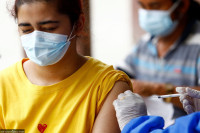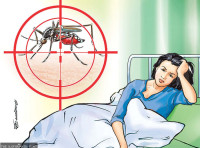Health
How Nepal’s data reshaped global vaccine policy
Patan Hospital’s research with Oxford Vaccine Group helped WHO-SAGE revise vaccine schedules and expand typhoid vaccination worldwide.
Arjun Poudel
Until 2005, Nepal had to rely on evidence from studies on childhood illnesses carried out in foreign countries. However, with the generation of homegrown data from 2005 through collaboration between Patan Hospital and the Oxford Vaccine Group, the country not only introduced new vaccines in its routine childhood vaccine list and saved hundreds of lives, but also helped reshape the global vaccine policy.
And it has already been 20 years of collaboration. Over these years, the partnership between the hospital and the group has shaped the recommendations of the World Health Organisation-Strategic Advisory Group of Experts (WHO-SAGE) on Immunisation regarding vaccine schedule flexibility and typhoid vaccine rollout. Moreover, it has generated crucial evidence for understanding childhood illnesses.
“First we studied meningitis, sepsis, pneumonia, among other disease burdens, in Nepali children in our hospital,” said Dr Srijana Shrestha, professor of paediatrics at Patan Academy of Health Sciences. “The study helped us generate local evidence on disease burden, present the scientific findings to the government and international community and influence national as well as global vaccine schedules.”
At that time, meningitis, sepsis and pneumonia were among the deadliest childhood diseases in Nepal, killing scores of children every year.
Meningitis is the inflammation of the tissues surrounding the brain and spinal cord, which is associated with high risk of death and long-term complications.
Similarly, sepsis is also a leading cause of morbidity and mortality in Nepal from which children and newborns have been much affected. Neonatal sepsis is a major cause of infant mortality, according to doctors.
Pneumonia, an infection of lungs caused by various types of bacteria, viruses and fungi, is the number one killer of children under five in Nepal. It kills more children annually than malaria, tuberculosis, and HIV combined.
In 2015, Nepal included pneumonia vaccine on the regular immunisation list to prevent under-five mortality, and became one of the first countries in Southeast Asia to do so.
Shrestha said that at that time, three types of pneumonia vaccines (PCV-7, 10 and 13) were available that protected against 7, 10 and 13 serotypes of the pathogen, respectively. Child health experts in the country and experts from aid agencies wanted to use PCV-13. But PCV-13 comes in single dose vials only and if it was chosen, there would be the issue of vaccine storage.
“The results of the study carried out in our hospital showed that the PCV-10 vaccine that comes in multi-dose vials, covers most of the pathogens responsible for pneumonia in our country,” said Shrestha. “We passed the information to the government that helped to take the decision to include PCV-10 in the routine immunisation list.”
Likewise, Nepal introduced pneumococcal conjugate vaccine using a unique 2+1 PCV schedule, with primary doses at six weeks, 10 weeks and a booster shot at nine months of age. The government’s decision was guided by evidence from the study conducted at Patan Hospital.
The study showed that a 2+1 PCV schedule generated a strong immunogenic response, and that a four-week interval between doses was safe and effective, and this was as effective as the WHO standard schedule.
The World Health Organisation-Strategic Advisory Group of Experts on Immunisation acknowledged the study's report and recommended vaccine schedule flexibility that the gap between the two doses can be shortened to four weeks. Many countries across the globe follow the 2+1 schedule at present, according to doctors.
Along with this, the hospital also carried out human trials of the typhoid vaccine on 20,000 children seeking treatment at Patan Hospital in collaboration with Oxford Vaccine Group.
Typhoid fever, usually called typhoid, is a highly contagious disease caused by Salmonella typhi, which spreads through contaminated food or water. Studies have shown that the disease can be fatal in up to 10 percent of the reported cases.
Typhoid fever is found throughout the world but the problem is acute in the areas where safe drinking water and sanitation is a problem. Nepal has also recorded major typhoid outbreaks in the past, but very few cases have been reported in the past few years.
In 2022, Nepal introduced typhoid vaccine into its regular immunisation list and launched a nationwide campaign during which around seven million children under 15 years of age were inoculated. Doctors say evidence generated in Nepal supported the funding decision of the Global Alliance for Vaccine and Immunisation (GAVI) and the UN health body’s recommendations for global rollout of the typhoid conjugate vaccine.
“Without Nepal’s data, typhoid vaccine would not have scaled globally,” said Shrestha. “Data generated by our country provided critical evidence that became a cornerstone in formulating policies for saving lives.”
Experts say Patan Hospital’s collaboration with Oxford Vaccine Group shows high-level research is possible in low-resource settings like Nepal, if long term investments are made, health facilities are strengthened and trained human resources are ensured.




 8.12°C Kathmandu
8.12°C Kathmandu














